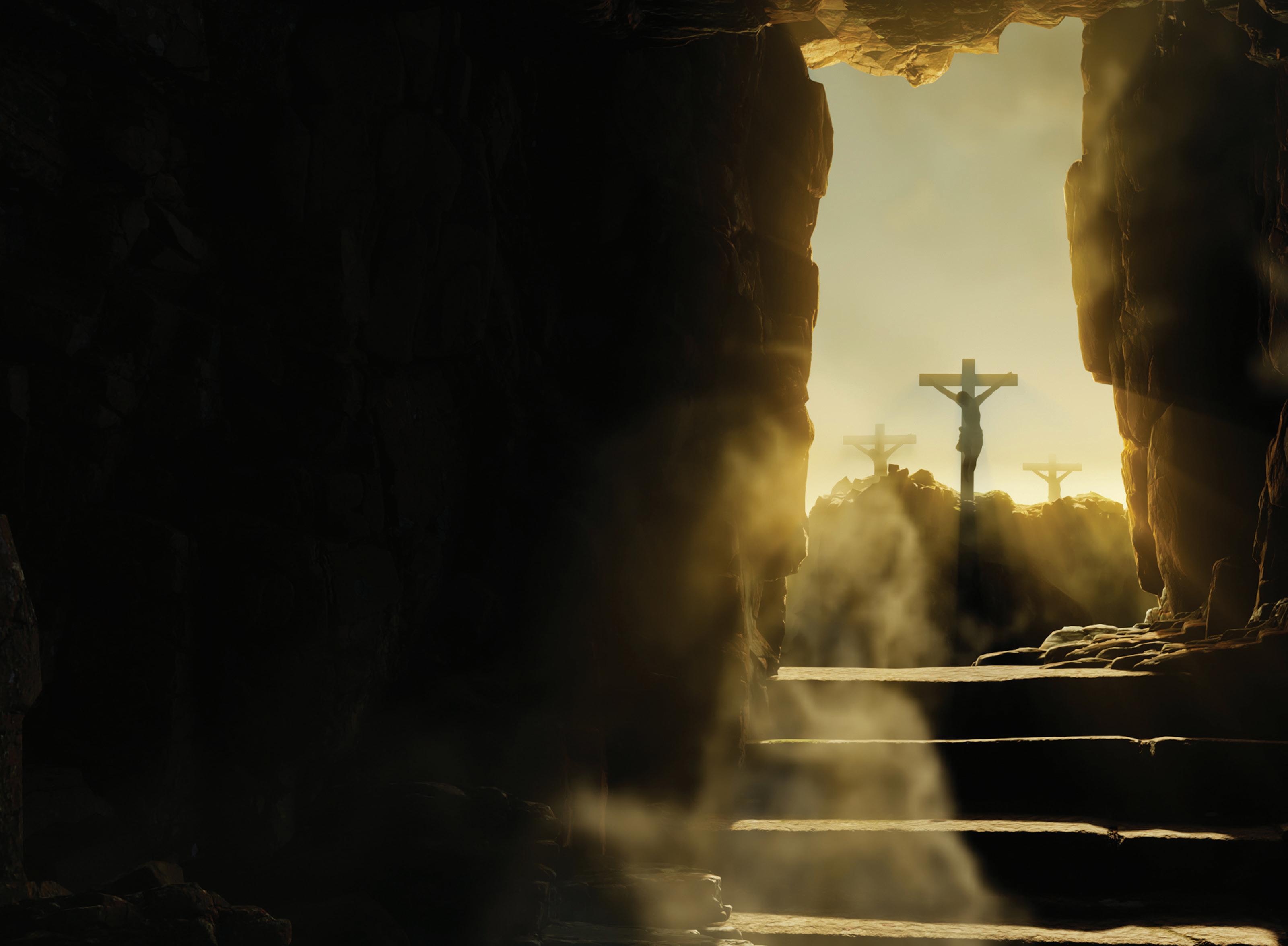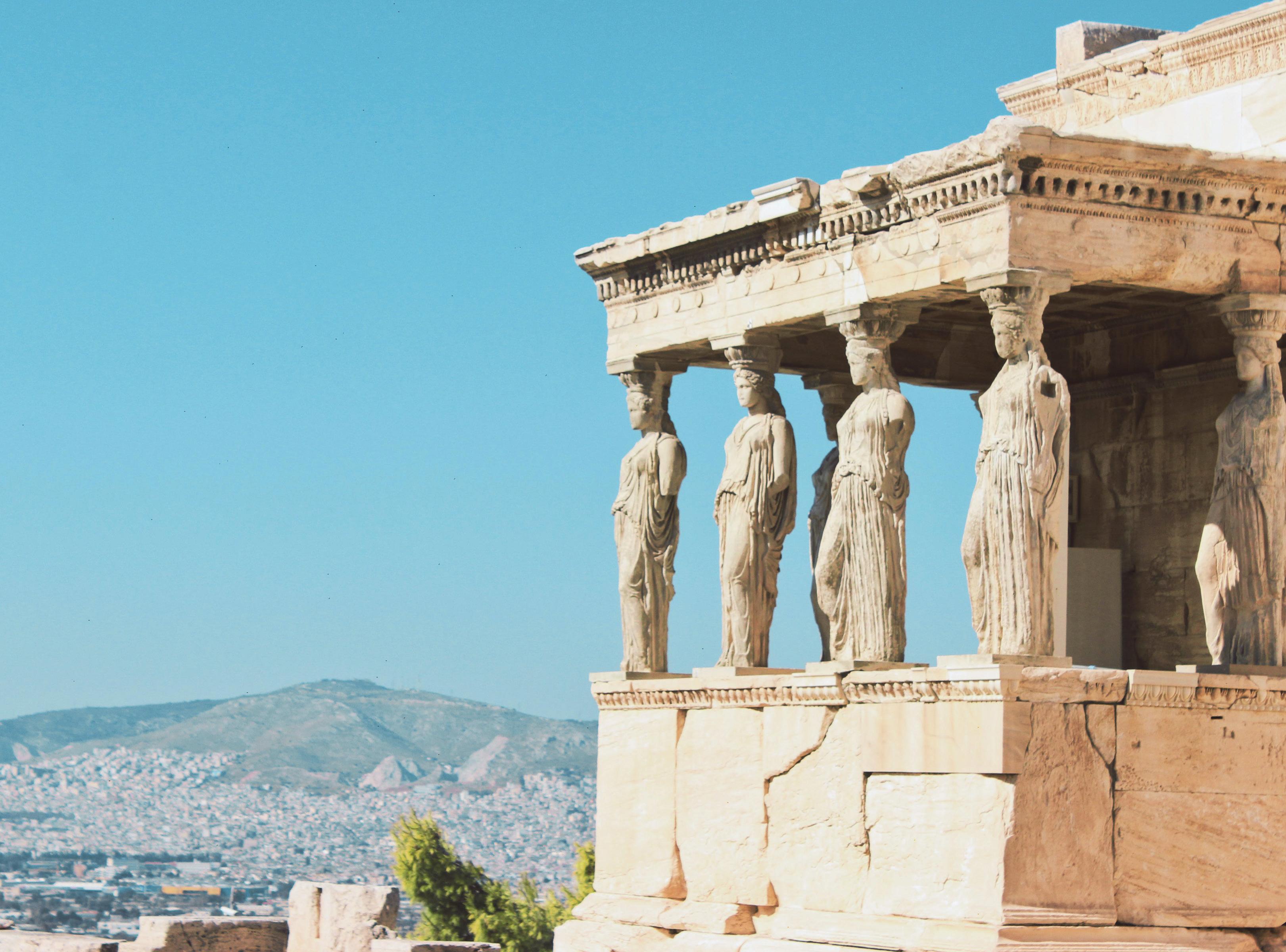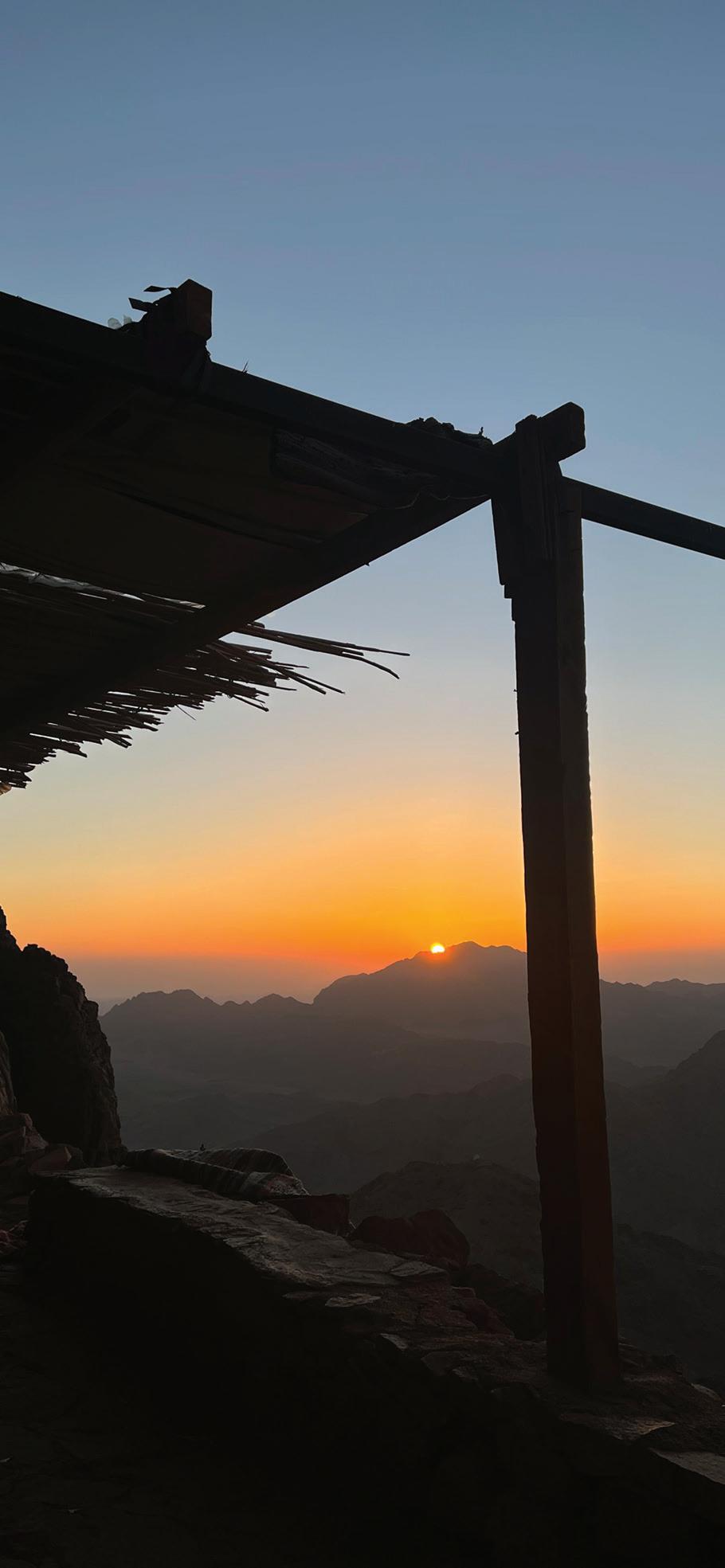the death of Death

a christian perspective on the world today

THE DEATH OF DEATH: EASTER & ETERNAL LIFE
Our quest for eternal life and the real solution found in a carpenter’s death
PAGE 32


a christian perspective on the world today

Our quest for eternal life and the real solution found in a carpenter’s death
PAGE 32
WHAT IN THE WORLD 04
RELIGION IS GOOD FOR YOU—REALLY? 06
THE “MEN’S SHED SOLUTION” FOR MALE LONELINESS 12
BIBLE ECHOES THROUGH A BROKEN STONE 18
PIRATES, PIGS AND SNAKES: THE REAL ST PATRICK 24
ASK PASTOR JESSE 30



IS THE ISRAEL-HAMAS CONFLICT THE BEGINNING OF THE END? 40
AN ANCIENT STORY WITH A DIFFERENT ENDING 48
BETTER HEALTH FOR EVERY BODY 54
MY HEAVENLY DAD 56
SUDOKU AND CROSSWORD PUZZLE 62
The year is in full swing and I’ve been thinking about joy lately. Not my mother, although her name is also Joy. But the state of being that someone finds themselves in that can only be described by this humble yet fun threeletter word. Joy. Say it to yourself a few times. “Joy”, “joy”, “joy”. Don’t worry if someone looks at you, it’s just for fun. They can lighten up.
Joy is a powerful emotion. It can catch hold of you and give you a shiver as you revel in touching, just for a second, the wriggly electricity of it. But it is more than an emotion. Joy is a state of being—and it is a choice. Just like love is a choice, so is joy. You can fall out of joy, just as you can fall out of love, but not if you’re pursuing it intentionally. How do you choose joy? Well, gratitude is a good discipline. Practising daily gratitude and counting your blessings help to put you in a positive and eventually joyful frame of mind. You can find joy even in grief and hardship if you choose to look on the bright side.
Joy is difficult to find if you are running on empty. So, spend some time looking at the sunset (or sunrise if you can manage it), read a good book, eat a sweet treat (just a little one), go for some exercise (those endorphins will have you feeling ecstatic) and make sure you are taking good care of your health. Then, joy will be easier to find. This March, as we celebrate Easter, may you also pursue joy in your life. And finding it, may you hold it tight, choose it daily and share it with those around you!

VOL 138 NO 7
ISSN 1038-9733
EXECUTIVE PUBLISHER
Brad Kemp
EDITOR
Jarrod Stackelroth
ASSOCIATE EDITOR
Jesse Herford
ASSISTANT EDITOR
Zanita Fletcher
COPYEDITOR
Tracey Bridcutt
GRAPHIC DESIGN
Theodora Pau’u
Talia Valderrama
PHONE +61 2 9847 2222
EMAIL info@signsofthetimes.org.au
WEBSITE
signsofthetimes.org.au
ADDRESS
Adventist Media PO Box 1115, Wahroonga New South Wales 2076
SUBSCRIPTIONS
Kelli Geelan
PHONE +61 3 5965 6300
Australia/New Zealand, $A28/$NZ30; South Pacific countries, $A41; Other countries $A51
Published since 1886, Signsof the Times is printed 11 times a year by the Seventh-day Adventist Church and is registered as a periodical.
Seventh-day Adventist Church (SPD) Limited
ABN 59 093 117 689
JARROD STACKELROTH Editor
NOTE The inclusion of a person or their image within does not imply their endorsement of the Seventh-day Adventist Church or its beliefs.
Unless otherwise stated, Bible verses are from the Holy Bible, New International Version®, Anglicised.
Copyright © 1979, 1984, 2011 by Biblica, Inc®. Used by permission of Hodder & Stoughton. All rights reserved worldwide.
COVER IMAGE:
CREDIT

Who
UNITED STATES
NASA astronaut Frank Rubio harvested one of the first tomatoes ever to be grown in space onboard the International Space Station. It was a big moment for the tomato . . . until Rubio lost it. Other astronauts accused him of eating it, but Rubio denied the rumour. Eight months later the tomato was found and Rubio was cleared. Where it was found remains confidential, but it was not in good condition. In good news, we now know tomatoes can be grown in space. Space.com

UNITED KINGDOM
More than 10,000 research papers were retracted in the last year, a new annual record. Publishers found a mass of articles containing incoherent text, strange wording choices used in efforts to evade plagiarism, irrelevant references and signs of the use of artificial intelligence. Of those retracted, experts say this was only the tip of the iceberg and that flawed papers are estimated to be in the hundreds of thousands. Nature Journal
AUSTRALIA
Ever wondered why most planes are painted white? Well, turns out this simple choice plays a key role in the airline business. White planes are more efficient than dark planes, being that lighter paint is literally lighter. Dark paint is heavier because it has more pigments in it and can add the equivalent weight of eight extra passengers. ABC.net

NEW ZEALAND
Traditionally the choice of chefs and uncool dads, many still cringe at the rubbery shoe brand Crocs, yet they have become one of the trendiest shoes on the market and many are styling them with colourful, metal charms. This has led to issues in schoolyards around New Zealand. Some schools have even decided to ban Crocs due to too many lost charms, metal pins falling off, ankle injuries and disputes as older students make unfair trades with younger kids.—9 News

FIJI
The nation of Fiji has one of the highest rates of pornography use in the Pacific and is ranked in the top 10 countries of internet porn traffic. Deputy prime minister Manoa Kamikamica said the rise of porn use has come with a rise in sex crimes. Members of parliament in Fiji are working together to educate on consent and healthy relationships, as well as ways to reduce high volumes of porn-related internet traffic. ABC.net
 PIXABAY—PEXELS, WIKICOMOONS, BAPTISTE VALTHIER—PEXELS, INCHES—PEXELS
PIXABAY—PEXELS, WIKICOMOONS, BAPTISTE VALTHIER—PEXELS, INCHES—PEXELS

The “really?” in the title is in recognition that religion doesn’t get good press at times—sometimes deservedly so.
Think about the Crusades. Or Martin Luther—a Christian hero among Protestants—who called for the extermination of Jews. Think about Jim Jones’ Peoples Temple and the mass suicide of 900 in 1978. Think about planes being flown into buildings in New York. Think about David Koresh’s Branch Davidian cult. That’s merely a short, illustrative list—and, as a Christian myself, I focused, with one exception, on groups or individuals with Christian roots that I find embarrassingly contrary to Christian teaching. I’m sure you could come up with more illustrations. It’s no wonder the atheist philosopher Bertrand Russell once described religion in general “as a disease born of fear and as a source of untold misery to the human race”.
religion under the microscope
sentiments that were carried out in what he calls “the messy thick of life as opposed to sterile labs, have led to the design of what we might call spiritual technologies—tools and processes meant to soothe, move, convince,or otherwise tweak the mind”.
“Studying these so-called technologies has revealed that certain religious practices, even when removed from their spiritual context, are able to influence people’s minds in the measurable ways psychologists often seek.” This allowed him to compare the effectiveness of these customs.
He and his colleagues were surprised when they found evidence of the benefits of religion. They recognised that this was “a sign of our hubris, born of a common notion among scientists: All of religion is superstition and, therefore, could have little practical benefit.
Religion has often been maligned in both the press and popular culture. But could believing give you an edge in life?BRUCE MANNERS
Research psychologist David DeSteno notes that “science and religion have often been at odds”.1 In his research into religion, though, he first separated the belief or theology from the practice of religion. Instead of looking at the beliefs of various religious groups, he and his team looked at the “rituals, customs and sentiments”. He explains that over time— sometimes over thousands of years—these rituals, customs and
“I’ll admit that we’re unlikely to learn much about the nature of the universe or the biology of disease from religion. But when it comes to finding ways to help people deal with issues surrounding birth and death, morality and meaning, grief and loss, it would be strange if thousands of years of religious thought didn’t have something to offer.” While noting that science and religion seem to have no compatibility, DeSteno admits, “When you look at the day-to-day practice of religious faith, the animosity in the debate evaporates.”
He now sees science and religion as “two approaches that frequently complement each other”. In case you’re wondering, “It’s not that I’ve suddenly found faith or have a new agenda to defend religion. I firmly believe that the scientific method is a wonder and offers one of the best ways to test ideas about how the world works. Like any good scientist, I’m simply following the data without prejudice. And it’s humbling.”
other voices
Science writer David Robson says the “stress-reducing, life-extending benefits of religion can offer useful strategies even for non-believers”. Doug Oman, a professor in public health at the University of California Berkeley, says “religious and spiritual traditions give you access to different methods of coping that have distinctive benefits”.2
Robson adds, “Studying the life-extending benefits of religious practice can therefore offer useful strategies for anyone—of any faith or none—to live a healthier and happier life . . . the evidence base linking faith to better health has been decades in the making and now encompasses thousands of studies.”
The research “found that measures of someone’s religious commitment, such as how often they attended church, were consistently associated with a range of outcomes, including a lower risk of depression, anxiety and suicide and reduced car-

diovascular disease and death from cancer”.3
A Pew Research study of the United States and “more than two dozen other countries” found that “regular participation in a religious community clearly is linked with higher levels of happiness and civic engagement (such as voting, joining community groups or other voluntary organisations)”. The researchers found that the religiously active individuals also “tend to smoke and drink less, but they are not healthier in terms of exercise frequency and rates of obesity”.
The report suggests that societies with declining levels of religious engagement could be risking declines in personal and societal wellbeing. It’s worth pointing out, religious affiliation, by itself, did not lead to more personal happiness or civic involvement. The religious package and involvement are both important.4
six benefits of religion
Psychology professor Andy Tix has found five unique benefits of religion. Individually they may not be unique, but together they cover what happens within mainstream religious— and particularly Christian—groups and gatherings. The sixth benefit is found from other research.
1. Community is inherent to religion.
“Religiousness includes engagement with a group of people that, to some extent, share similar values and behaviour.” Tix adds that in developed countries, membership and involvement in clubs and other social groups have been in decline since the 1960s. “With increasing individualism, isolation and loneliness are on the rise and often are identified as driving forces behind rising rates of psychological disorders. Humans demonstrate a strong need to belong. Religion helps meet this need.”
2. Religion exposes you to different perspectives.
“Religious communities can include individuals that can be surprisingly different from each other. In fact, religious gatherings may provide an increasingly rare venue in our society to bring people from various kinds of backgrounds together.” He uses the example of congregations where wealthy and poor mix and “individuals may be forced to stretch their perspectives or wrestle with insights they may not have identified on their own”.
3. Religious rituals create meaning. Many of these rituals are passed down from generation to generation. Connecting with rituals that seem ancient may help those involved “experience a deep sense of meaning or reverence”. “Rituals can be especially welcome during times of transition, such as birth, death, marriage and other ‘rites of passage.’”
4. Religion often emphasises music. “There aren’t many opportunities for local communities to sing, play or
listen to live music together, but religious communities often provide one such venue.” Further, sacred music may have its own unique benefits, as can be seen by individuals who become moved to the point of tears, chills or goosebumps during such musical experiences. In this way, worshipful music may be a potent source of awe for many people.”
5. Religion encourages collective action.
There may be important benefits to being a part of an institution that prioritises action. That may make it easier to get involved in a cause to make a significant difference in society. After all, history shows that religion has played significant roles in creating hospitals, health centres, schools, and homes for the elderly and those with special needs. “Individuals who aid in such efforts may feel greater purpose in life. They may help make the world, in fact, better.”5
6. Religion may help you live longer.
Laura Wallace from the University of Chicago Booth School of Business examined the obituaries of 1000 individuals and looked at whether there was any evidence of religious affiliation—signifying that their faith had been a major element of their identity.
She published her results in 2018 and noted that “those people marked out for their faith lived for 5.6 years more, on average, than those whose religion had not been recorded”. She followed this research by checking obituaries from Des Moines in Iowa

Religion has played significant roles in creating hospitals, health centres, schools, homes for the elderly and those with special needs
some of the tools religions provide can be used for evil purposes. But that’s not a reason to indict the entire enterprise, especially when there’s ample evidence that other items in religion’s toolbox can help foster people’s noblest traits”.
So, good religion comes back to its practitioners. Those of us who are people of faith are the ones who can make it good when we use religion’s toolbox to “help foster people’s noblest traits.” That’s what makes religion good.
and found “the difference was even greater—about 10 years in total”. This, she says, “is on par with the avoidance of major health risks—like smoking”.
religion is good for you . . . if There’s adequate evidence that religion is good for us, with involvement as a significant factor. DeSteno has another helpful contribution. After clarifying that he shouldn’t be seen as an apologist for religion, he says, “My goal isn’t to argue that religion is always good. I fully recognise that religious beliefs have been used to motivate and justify horrendous acts of violence and abuse, to perpetuate many types of discrimination and inequality, and to push people toward many kinds of irrational behaviour.
“Religion’s value depends on the intentions of those using it. Yes,
Bruce Manners is an author, retired pastor and former editor of the Australia/New Zealand edition of Signs of the Times. He is based in Lilydale, Victoria.
1. All quotes from David Desteno are from his book How God Works: The Science Behind the Benefits of Religion, Simon & Schuster, 2021.
2. <theguardian.com/world/2022/dec/03/beyond-beliefs-religious-faith-happier-healthier-life>
3. Op cit.
4. <pewresearch.org/religion/2019/01/31/religions-relationship-to-happiness-civic-engage >
5. <psychologytoday.com/au/blog/the-pursuit-ofpeace/202303/5-benefits-of-religion-comparedwith-spirituality ment-and-health-around-theworld/>
6. <hbs.edu/ris/Publication%20Files/mochon%20 norton%20ariely%20who%20benefits%20from%20religion_e072e4b1-8c04-4698-9cdf-e2d27b1f237d.pdf>
For many Australians, Men’s Sheds offer somewhere to go. I visited my local shed to find that, among the many things they have built, the community is perhaps the most impressive.

This article is dedicated to Peter (pictured bottom left), who passed away in December 2023, a few weeks after this interview was recorded. Peter was an iconic character of the shed and will be sorely missed. He was there only a few days before he passed.
ZANITA FLETCHEREnter the The Woodwork and Craft Club in southeast Queensland and you’ll see piles upon piles of wood and wooden goods—finished, unfinished and not even started. Everything from chests, dollhouses, stools, chessboards, lamps, birdhouses and much more.
Behind the stack of projects hangs a black-and-white framed photograph of an old man with a plaque below that reads Tom Rolfe. When I ask the men in the shed about him as we sit down for morning tea, I hear, “Oh, he passed away a long time ago.” I’m told about his quest for a place like this and of the deals he made that eventually got him prime land at a cost of close-to-nothing. The men tell stories of Tom and laugh about him as if he’s still at the table with them. Before my tea even had the chance to cool down enough for me to take a sip, I realised there was something special about this place. a history of sheds
The loss of work and sense of purpose can make retirement challenging
more than 1200 sheds in Australia and more than 2500 worldwide, with more popping up in countries like Ireland, Canada and New Zealand. While the one I visited isn’t exclusively a “men’s” shed, it is mostly retired men who attend regularly. Though they welcome women and young blood with enthusiasm. According to the Australian Bureau of Statistics, the average age of retirement for males is 59 years, meaning many spend decades of their lives outside of paid work, a place where they often find their sense of fulfilment.1
The loss of a work routine and sense of purpose can make retirement challenging. For men who don’t find new meaningful activities to replace work, there is the risk of boredom and a sense of purposelessness that can be stressful and can lead to depression and other health problems.
meeting the rabble
As it neared 9:30am, one man said, “The rabble should be turning up soon . . . they always flood in just in time for smoko.” Those who were there started telling me how the shed works, about different members and projects within sight. Various men from a range of ages and many walks of life trickled in, as predicted. The jug was boiled numerous times, and a barrel of biscuits covered in a thin lining of sawdust was passed from one set of hands to the next.
Richard, a recently retired tax lawyer, rode in on his black Harlem Fatboy electric bike. As he pulled up, Ian, once a welder by trade, turned to me and said, “Should change that to old boy.” He laughed but I could tell he’d made that joke before. Richard and Ian have been regulars for years and I got the impression the shed has been a very big part of their lives.
Since the first time he heard a ship coming into Sydney Harbour as a boy, Peter has been fascinated with boats. He spent his former years as a boat builder and shipwright and, for the last decade, has been coming to the shed nearly every day to work on faithful reproductions. He showed me his latest project, The Yawl, a 1902 tier masted grass-green sailing vessel. There are a few men older than Peter, who also ride in on their scooters, but he’s the longest running regular of which he made sure I noted.
Then there were the two Micks. One makes sculptured creatures that he sometimes sells off to a local cabaret venue or otherwise leaves at the shed entrance to give people
Men’s sheds, or community sheds, originated in Australia to improve the health and wellbeing of older men. Since the first community shed opened in 1993, the Australian-born movement has grown to include
“When you’re used to working and all of a sudden there’s nothing, you’re lost. You want to be doing things still,” said Ian, who comes to the shed nearly every day. “We have gotten a few women come in with their husbands and get them to join up. Mainly to get them out of the house or give them something to do.”
“A lot of the time what we make is orientated on whatever timber we’ve got hanging around. We think, What could we make with that? Rather than think we want to make this and then let’s find the timber. That’s too expensive . . . A lot of the time we use old crates and most of our timber is donated,” Ian said. “We’re the ultimate recyclers,” Richard chimed in, pulling out a small branch of bottlebrush he found in his garden that he thought would make a nice bowl.
The rain started to hit the tin roof when Peter, 86 years of age, rolled in on his mobile scooter. I’d already heard about him and his model boats.


a fright. He dreams up things and makes them on the whim. He doesn’t measure much. Just gets a chunk of wood and grinds away at it until he likes what he sees. Then there’s the more calculated Mick, a retired carpenter who does precision work and who struggled to sit down for tea because he was eager to test out a new machine. “He’s one of our skilled operators. Quite the craftsman!” one said. “A what?” Mick replied, shrugging off the compliment. “A craftsman!” I watched him at work later and can vouch he’s exactly that.
On top of the projects the men go about individually, they make time to do things for the community. Recently they made a dozen garden beds and potting benches specifically designed for wheelchair access. This was for a community garden for the physically impaired, an initiative by their local neighbourhood centre.
During school term, they facilitate classes for the students at the
school the shed resides on. “It’s really rewarding working with the kids and being able to teach them different things,” one said. He explained that they always have more men come in when they are involved in teaching the students.
The men also attend community markets every now and then to sell what they’ve made. “It’s good for guys to come along to the shed, but if they don’t have a project of their own, they can build something to sell. It gives them a project to do and it’s good for their ego knowing someone will buy it,” another said.
As morning tea wrapped up, the men drifted to various parts of the shed and got back to work, chatting, helping each other, and grabbing another cuppa. This was a typical day there. And while it may sound like a bunch of men pottering around, it’s much more. It’s a place where people value one another’s company, where they can put their hands to good work and pour themselves into something they’re proud of.
Research conducted by Beyond Blue shows that men who frequent these clubs experience a host of benefits. They feel better mentally, emotionally and physically. They experience less pain, are more sociable, optimistic, relaxed, confident and cheerful. They also report that they feel useful and better about themselves, which might be because they help people in their communities.2
“Thousands of people around the world live longer and happier lives thanks to their humble shed,” said David Helmers, CEO of the Australian Men’s Shed Association.
We often hear about the importance of community. Of the power it has to change us, ease our angst, brighten our mood, add to our sense of purpose and even increase our lifespan. But community isn’t always easy to find, and we don’t always desire or miss it unless we’ve been a part of one. But once you’ve seen it in action or experienced it, you know that it’s one of the greatest, most underrated things life has to offer.
From my brief time at The Woodwork and Craft Club, I could tell that this was a place where community and comradeship were valued. It reminded me of a few things about community that we can each take with us into various contexts.
The first is that community takes effort. We don’t just stumble upon it. At some point, each man there had to enquire about how to join, ask about
machinery and tools, and start from scratch with new relationships.
The second is that there is beauty in our differences. So often we choose to spend time with people who are just like us. But there is value in connecting with people from different walks of life, of different ages, with different skills and interests.
Lastly, there’s power in serving. Not only does it give us a sense of purpose and fulfilment but it brings us closer together.
Whether you’re part of a community or searching for one, my hope is that you take a note from the men at The Woodwork and Craft Club and sink yourself into a community in which you can belong and contribute. If we surround ourselves with people who are positive and supportive, our lives will be better for it.
“Alright kiddo, lovely seeing you,” one says as I make my way out. “Take care. Come back again,” another says. I’m gifted with a wooden surfboard keyring and a reindeer they made to sell at the markets for Christmas. I leave, though not really wanting to, and look forward to when I can return . . . And that is a sure sign of a place and a community I hope we all get to be a part of.
Zanita Fletcher is a life coach and assistant editor for the Australia/New Zealand edition of Signs of the Times. She writes from the Gold Coast, Queensland.
1. <smartmonday.com.au/news/how-Australians-live-in-retirement>
2. <beyondblue.org.au/docs/default-source/research-project-files/bw0209.pdf?sfvrsn=2>

The ancient origins of the use of God’s divine name.
TOR TJERANSENAblack basalt stone found in the desert of Jordan has an inscription with the earliest known use of the name of Yahweh (one of the many names for the Old Testament God). It is one of many ancient items which confirm biblical history. A Frenchman by the name of Frederick Klein was the first European to see the stone. Unfortunately, he was also the last one to see the stele1 in one piece. The stone is now on display in the Louvre museum in Paris. If you visit it today, you’ll see that the stone has been broken into many pieces. It wasn’t through some natural event or accident—the stone was damaged on purpose by the Bedouins (a nomadic people group native to the Israelite Negev desert).

Despite its fragmentary state, it is still an extremely important historical item. Archaeologist Siegfried Horn said, “Its importance as an ancient monument can hardly be overemphasised.”2 Today, the destruction of cultural objects is not only considered a crime, but thought of by many as an attack on humanity’s past. Such sentiments were not present when the Bedouins of Dhiban decided to destroy the monument.
Frederick Augustus Klein was an Anglican missionary who began his ministry in Israel in 1851. In 1868, he travelled on horseback to Jordan, to the village of Dhiban. Dhiban is situated four kilometres north of the Wadi Mujib, a deep canyon where the biblical river Arnon flows towards the Dead Sea. When he arrived in the village, he was shown a stele about one metre tall lying on its back with text engraved on its face. Klein checked the back to see if there was an inscription on both sides. There was not. Today, this stone is known as the “Moabite Stone” or “Mesha Stele”. Both terms are references to the Moabite king by the name of Mesha who had the monument and inscription made.
Klein realised that the stone was an important object and the Berlin Museum tried to purchase it from the Bedouins living in the area. However, they asked an impossibly high price for it. France, Britain and Germany all began a competition
to recover the stele for themselves. Eventually, the Turkish government got involved and was ready to send soldiers to claim it by force. The Bedouins were so enraged that they broke the stone in pieces by heating it with fire and pouring cold water on it. The pieces were distributed among Bedouin families.
Over the years, three people were able to obtain 57 fragments of the stone, which represents about two-thirds of the original. It would have been a very difficult task to put the pieces together had it not been for the fact that in 1869, a man by the name of Yacub Karavaca created a paper squeeze of the inscription. He did this by pressing wet paper onto the monument and peeling it off after it dried. Unfortunately, it was not of very good quality because while Karavaca was performing the squeeze, a fight broke out among the Bedouins and Karavaca tore off the paper before it had dried, fleeing for his life. Even though the wet paper Karavaca had squeezed tore in several pieces as he fled, it became the guide to fit the broken pieces together and determine what the rest of the inscription was.
war propaganda
So, what does the Moabite Stone actually say? The stele was written in Phoenician script and dated to about 840 BC. It is a description of how King Mesha of Moab revolted against the king of Israel and conquered several Israelite cities. The text is
The destruction of cultural objects is not only considered a crime, but an attack on humanity’s past
a parallel to the biblical account found in 2 Kings 3. The authors of 2 Kings record that Joram became king of Israel after Ahab and “after Ahab died, the king of Moab rebelled against the king of Israel” (2 Kings 3:5). The Moabite Stone gives the Moabite version of this rebellion. Undoubtedly, the monument was made to strengthen Moabite identity and remind the people of the sovereignty of the king. It can best be described as a piece of propaganda. Joram, the king of Israel, did not want the rebellion by Moab to succeed. He went to war against Moab and enlisted the help of Jehoshaphat, the king of Judah, in addition to the king of Edom, the nation just south of Moab. The three kings attacked Moab from the south—a strategy probably chosen because the northern border of Moab was cut by a huge gorge where the Arnon river flows. Even today, Wadi Mujib, the current name of the canyon, is a border between two administrative divisions of the country of Jordan. The Madaba
Governorate is in the north and the Karak Governorate in the south of the canyon.
In the biblical text, we are told that Mesha ultimately lost and as a result paid “a tribute of a hundred thousand lambs and the wool of a hundred thousand rams” (2 Kings 3:4). The stele corroborates this detail.
biblical significance
In line 18 of the text, Yahweh is mentioned in contrast to the Moabite god Ashtar-Kemosh. The name of Yahweh is spelled the same way that it is spelled in the Hebrew Bible. This is the earliest use of the name of Yahweh in any known text, including the biblical text. The text of the Moabite Stone also confirms that the tribe of Gad lived in the area north of the Arnon river (Wadi Mujib), as recounted in Deuteronomy 3:12. It’s the longest Iron Age inscription found in the area, which makes it culturally and historically significant outside of its biblical importance. It’s one of four contemporary texts that
reference the nation of Israel and it’s a wonderful example of Moabite language and culture. The Mesha Stele or Moabite Stone is a clear confirmation by a contemporary text outside of the Bible of events described in the Bible. As such, it places the biblical text within a historical context—a context that can be verified through external pieces of evidence.
If you are in Paris, make sure to visit the Louvre and find your way to the Palestine and Transjordan collection in hall 3033 to admire the Moabite Stone and consider its dramatic history.
If you (like me) are a reader of the Bible, perhaps the most exciting implication of this text is that we are still participating in its history.
Tor Tjeransen is the communication director for the Seventh-day Adventist Church in Norway.
1. A stele is a stone or wood slab that was often used in the ancient world as a monument to a royal figure or to represent a divine image.
2. <library.biblicalarchaeology.org/article/why-themoabite-stone-was-blown-to-pieces/>
3. <collections.louvre.fr/en/plan?niveau=0&num_ salle=291738>





Disclaimer: Although Signs of the Times does not recognise the sainthood bestowed on historical Christian figures by the Catholic Church, we use the term “St Patrick” in this article for identification purposes.

The patron saint of Ireland is a legendary figure and all around the world on March 17 he’s celebrated by those who claim Irish heritage. But who was he really?
And do the legends stack up to the facts?
JESSE HERFORDShamrocks, leprechauns and green beer: these are the images we associate with the patron saint of Ireland and the day named after him. On March 17 every year, people around the world gather to celebrate Irish culture and the saint who supposedly espouses it. So, that begs the question, who was the historical Patrick, how much of what we know of him is based on fact and how much is pure fiction?
The good news is that Patrick’s life was probably based on a true story, so let’s start there. The first undisputed fact you may find surprising is that the real Patrick wasn’t Irish. He was actually a Christian living in Roman Britain toward the end of Roman rule in the British Isles. There have been many disputes as to the place of his birth, with some scholars forwarding the notion that he was originally from South Wales, Scotland or Northamptonshire, to name a few. What they all agree on is that Patrick wasn’t Irish.
Succat”, whereas others call him “Magonus” or “Cothirthiacus”. In his writings, he calls himself “Patricius”, which some think is more of a title, due to its close association with the Latin word for “father”. For this article, however, we’ll keep Patrick’s name simple.
We can safely say he lived around the fifth century AD, because his own writings are a mixture of Old Latin and Vulgar Latin, suggesting he wrote at a linguistic transitional point in history. Also at this time, Roman Britain had been largely Christianised but notably, Ireland was still a non-Christian nation of Celtic tribesmen and petty kingdoms.
Unlike the gilded lives of other saints, Patrick is much more honest
Differing hagiographies refer to Patrick by different names, all referencing supposed birthplaces or identifiers with famous landmarks. Some refer to him as “Maewyn
Though many accounts have been written about Patrick’s life, we will almost exclusively draw from his autobiography, called the Confessio. In it, he describes himself as “a simple country person” and “the least of all believers”.1 He goes on to say that despite his father being a deacon and his grandfather being a priest, in his teenage years, Patrick “did not know the true God at all”. Patrick’s story is interrupted when at the age of 16, he is captured by Irish pirates, along with “thousands of others”.

The pirates took Patrick to Ireland and sold him to an unnamed master. For six years, he lived as a slave. Far from home, his former lack of spiritual conviction changed radically, and he had something of a conversion experience. “Even though it came about late, I recognised my failings. So I turned with all my heart to the Lord my God, and he looked down on my lowliness and had mercy on my youthful ignorance.” What follows is a long confession of faith. Unlike the gilded lives of other saints, Patrick is much more honest. He says, “Although I am imperfect in many ways, I want my brothers and relations to know what I’m really like so that they can see what it is that inspires my life.” Here is a man who reckons with his flaws and expresses his awe to a God who accepts him despite them. “More and more the love of God increased, and my sense of awe before God. Faith grew, and my spirit was moved, so that in one day I would pray up to 100 times, and at night perhaps the same.”
After six years, God came to Patrick in a dream and told him that his liberation would soon be at hand. He was instructed to make a journey of 300 kilometres, whereupon he would find a ship that would bear him back home. Eagerly, he made the perilous
trip, found the ship and begged its captain to take him aboard. They reluctantly let him aboard and after three days of sailing, he was back in England. After many more misadventures, Patrick was home.
After reuniting with his family, Patrick studied to become a priest. Hearing the call of God once again, Patrick’s mission became to return to Ireland to convert the Irish people to faith in the Christian God. What follows in the Confessio is a scattered, vague series of accounts of Patrick’s missionary journey in the Irish Isles. He tells of wealthy Irish women converting to Christianity and becoming nuns, despite persecution from their families. He also mentions the growing number of Irish Christians who, despite cultural pressure, became the seedbed of what today we call the Irish Church. One of the greatest feats Patrick is said to have accomplished is abolishing human sacrifice. He believed and taught that God had offered Jesus Christ to them, as the end of all sacrifice. 2 Of course, no discussion on the life of Saint Patrick would be complete without exploring some of the legends that have become synonymous with him. Let’s take a brief look at two of the most famous ones.

When we think of the Holy Trinity—that is, the triune nature of God, the Father, God the Son and God the Holy Spirit—many of us go straight to the three-leaf clover synonymous with the Emerald Isles. Legend says that the shamrock was sacred to the Celtic Irish and was therefore chosen by Patrick to explain the concept of the Trinity to them. Expert on Irish spirituality Patricia Monaghan contended that there is no evidence that the shamrock was sacred to the Celtic Irish.3 Patrick himself makes no mention of this teaching of the Trinity in his writings, and the earliest account we have of such a tale is found in the 18th century, which means the tale of the shamrock is probably made up. the isle of snakes?
Probably the most popular story surrounding Patrick is his supposed banishing of all snakes from Ireland. The story goes that Patrick was atop a mountain (that would later
be known as Croagh Patrick) amid a 40-day fast when all of a sudden, he was attacked by a horde of snakes. Harnessing the wrath of God, he drove the snakes into the ocean and out of Ireland, permanently.
The story was never mentioned in his writings, with the earliest account of someone driving snakes out of Ireland attributed to another saint, Columba, in the seventh or eighth century. The story was later attributed to Patrick by Jocelyn of Furness in the 12th century. Of course, Jocelyn does not cite an earlier source. Later Christian historians mention the tale, but most of them are equally sceptical about its historical accuracy. Sadly, like the shamrock, this tale is probably a historical myth. from glory to gluttony
Officially made a feast day by the Catholic Church in the early 17th century, St Patrick’s Day has become a modern mainstay, despite its ancient origins. However, when we
consider the historical person and his place in Irish history, it’s surprising we still call it St Patrick’s Day at all. Excessive alcohol consumption, Irish nationalism and raucous behaviour better reflect the American culture that popularised the day than it does Saint Patrick himself.
Despite our cultural lack of familiarity with the historical Patrick, I must admit I was surprised by just how different a person he is compared to the myths. As is so often the case with religious figures, the legends told about their life create a gulf of incredulity to the point where they cease to be a person and morph into a mystical, almost inhuman icon. And yet, his impact on Christianity was profound. Following the Roman withdrawal from Britain, what had once been a Christian nation became muddied once again in the mire of various cultic beliefs and traditional
religions. The only bastion in this changing world was the Irish Church. Many years after the time of Patrick, Irish missionaries returned to Britain to convert the same people who had once converted them. In a very real way, Patrick saved Christianity in the British Isles.
So, the next time you see a shamrock or green beer, spare a thought for old Saint Patrick. Though his legacy diverges from his actual life, he still has something profound to say about the life of faith today.
Jesse Herford is a pastor and associate editor for the Australia/New Zealand edition of Signs of the Times. He lives in Sydney, Australia with his wife, Carina and their miniature schnauzer, Banjo.
1. All direct quotations from Patrick are from <https:// www.ewtn.com/catholicism/library/confession-of-st-patrick-5728>
2. <irishtimes.com/opinion/untrue-to-state-that-stpatrick-brought-misery-to-ireland-1.2141959>
3. Patricia Monaghan, The Encyclopedia of Celtic Mythology and Folklore. Infobase Publishing, 2009.


As a pastor, there are questions I’ve encountered over and over again, sometimes about the Bible but usually about everyday life. If you’ve never had the opportunity to ask a pastor tough questions this is the right place. I’ll do my best to respond authentically and biblically!
Was Jesus really a historical figure?
Ross, Blenheim NZ
The historicity of Jesus is a question that has largely been settled by most reputable academics. There were ideas floating around in the late 19th and early 20th century that doubted whether Jesus truly existed but that is now considered a fringe theory. Whether you believe Jesus was the Son of God and rose from the dead is one thing, but setting that aside, here is what modern historians agree on:
-That a Jewish man called Yeshua of Nazareth lived in the first century AD.
-That His life and teachings formed the basis of what is considered the Christian religion.
-That He was baptised by John the Baptist in either AD 28 or AD 29.
-That He was crucified by Pontius Pilate, the fifth governer of Judea, in either AD 30 or AD 33.
As to the historical accuracy of the Gospel accounts, letters of Paul and other New Testament writings, these are all debated by historians and biblical scholars alike. However, the notion that Jesus of Nazareth was not a historical figure is patently absurd according to modern scholarship. He was a real person, and that’s a fact.
What’s so important about the resurrection? Why do Christians make such a big deal out of it?
Francine, Perth Australia
The resurrection of Jesus is the foundation upon which all Christian faith is built. Put simply: if we don’t have a resurrection, we don’t have a Christianity. The entire thing falls apart if Jesus truly didn’t rise from the dead.
The key claim in the resurrection is that in it, Jesus did three things.
First, He stood in your place that you would not be required to pay the price of your wrongdoings. When the first humans allowed sin to enter the world, they unknowingly signed themselves up for a horrific fate. Sin can best be described as a sort of cosmic horror—a force that, on the one hand offers ultimate power, but at the ultimate price: death. Every time you’ve lied, stolen, used violence; this is sin working through you. As we all know intuitively, such tactics, when taken to their logical conclusion, always end in death. Though that may sound dramatic, think of the lives of people like Robert Mugabe, Joseph Stalin or Ted Bundy. When Jesus died, He stood in your place so that you wouldn’t have to suffer the ultimate consequences of sin. As the apostle Paul once said, “For the sin of this one man, Adam, caused death to rule over many. But even greater is God’s wonderful grace and his gift of righteousness, for all who receive it will live in triumph over sin and death through this one man, Jesus Christ” (Romans 5:17).
The second thing that Jesus did
was win an ultimate victory. “Having disarmed the powers and authorities, he made a public spectacle of them, triumphing over them by the cross” (Colossians 2:15). It was not enough for Jesus to simply take your punishment.
On the cross, He broke the power of sin, thus declaring that death would no longer have ultimate authority in His world.
Third, Jesus invited His followers into a new way of being. Though we are still very much affected by the powers of sin and death, when we follow Jesus, we declare that though our body may pass away, death will not have the final say. As New Testament scholar NT Wright says, “The message of Easter is that God’s new world has been unveiled in Jesus Christ and that you’re now invited to belong to it.” Ultimately, the resurrection of Jesus is an invitation to live life in a new way. It’s to live with hope that no matter how dark this world becomes, one day God will be made king and good will triumph over evil. Why don’t you give it a try?
Want to get your question published in the next issue of the magazine? Ask Jesse a question by scanning the code below!

We all want to escape death in one way, shape or form. The ultra-wealthy are currently trying to beat it with science, but the resurrection of Jesus provides a better way to be free from death.
JARROD STACKELROTH
ltra-rich Silicon Valley tech magnate Bryan Johnson has been regularly having transfusions of his own son’s blood plasma in an effort to live longer. The treatments are expensive and are essentially still being trialled.1
A BBC Radio 4 podcast called The Immortals details how a group of people, mostly billionaires, are striving to unlock the secrets of living forever. Mr Johnson himself is reportedly paying $US2 million a year to a research team investigating longevity.
According to The Guardian’s review of the podcast, one of the world’s richest men, Amazon owner Jeff Bezos, is investing in a cellular rejuvenation program, while others are working on merging AI and machines—a sort of “next phase” of humanity.
The more research I do into this, the more it feels like science-fiction. One leading idea that has been prominent in science-fiction but is heading closer to being real life is the idea of living on digitally.
In the film Transcendence, a rich, eccentric character played by Johnny Depp, who is working on developing an artificial intelligence has his consciousness uploaded to escape death. This fantastical idea is seemingly getting closer to reality.
We see this resistance to death in the development of new drugs to fight ageing in dogs. According to
a New York Times report, the Food and Drug Administration (FDA) has cleared the first step for a company called Loyal to produce drugs that promise to increase a dog’s lifespan. We are uncomfortable with death and the death of “man’s best friend” happens more regularly than we’d like. In the hope of staving off the inevitable, humans are attempting to increase the lifespan of dogs. But there is an agenda in doing so.2
If the FDA will approve such a thing for animals, the hope is it will set a precedent for admitting that drugs can actually have an impact on human lifespans, making future approval slightly easier. While nothing may be available for a couple of years yet (2026 has been flagged as the earliest), it is a development that many are looking towards as a step in the journey to lengthen lifespans for humans.
Humans have long searched for immortality. Tales of the fountain of youth appear as far back as the writings of Herodotus (fifth century BC) and are found in many different cultures. Through the Middle Ages and beyond, the Holy Grail was one relic said to bestow healing and life on those who find and drink from it. The Pharaohs and rulers of ancient Egypt also sought life eternal, seeing death as a portal for a life that could be prepared for using the resources of this earthly life. They spent enormous resources building tombs and
pyramids, stocking them for use in the afterlife. In a way, mummification and embalming are almost like the sci-fi technique of having your body cryogenically frozen until you can be brought back to life.
Humans everywhere are ruled by the fear of death. For most of us, death is a few steps further away than it was for our grandparents. We’re not living hand-to-mouth and yet, we are still motivated by death. Work hard to survive. Get ahead of other people. Spend money on selfcare and health fads and snake oil in an effort to find an extra few years of life.
The one-percenters’ quest to stave off death using all the resources at their disposal is just the most recent iteration in this ongoing battle between ordered life and chaotic oblivion. Our striving against this slide back into the abyss is understood and explored by the biblical writers, who provide a powerful counter-narrative.
the Easter story
The Bible details the story celebrated by Christians at Easter time. It is found within four books that are collectively known as the Gospels: Matthew, Mark, Luke and John. Each writer adds different details and points of emphasis, but they all essentially tell the same story.
Jesus had been teaching, healing the sick and travelling around Judea and Galilee, followed by many, including His 12 disciples. After

Humans everywhere are ruled by the fear of death
three years of this, Jesus had everyone’s attention. The religious elites of society felt threatened by His audacious teachings. They thought that if He continued to gain popular support, He would draw the ire of the occupying Roman Empire and cause severe suffering to their people. They also feared what little power they had being taken away.
Jesus knew His days were numbered and tried to prepare His followers, including celebrating a Passover meal where He instituted the Christian practice of breaking

Those who followed Jesus in life were transformed into disciples who followed Him in death
unleavened bread and sharing wine as symbols of His body and blood. As you might remember, later in the evening, Jesus was then betrayed by one of His disciples, who led soldiers to arrest Him by cover of night. Any resistance that might have been put up by His followers was discouraged by Jesus, which led to them fleeing and hiding. A few mock trials followed as Jesus was shuttled between the religious and civil leaders and ultimately sentenced to death.
The cross was the most brutal form of execution the Romans could devise. Death was humiliating, agonising and prolonged. Condemned men and women were stripped naked and nailed to these coarse wooden crosses in an agonising position. To breathe properly they had to push up on their feet, which were nailed together at the bottom, otherwise, their weight would be taken on their shoulders. After hours of hanging, slowly they would suffocate. Often, they were whipped and beaten before being hung. Jesus died in
this way, after only hanging there for a few hours. He was placed in a borrowed tomb and left there over the Sabbath hours.
The triumph of the Easter story is in what happened on Easter Sunday—the resurrection. The stone was rolled away, soldiers were flung aside and when Jesus’ disciples came to check the tomb, it was empty. The Bible records many people who claimed to see Jesus alive and mysteriously, authorities were never able to produce a body.
Now, there’s a good chance you may be reading this cynically. Perhaps you doubt whether the resurrection truly happened. There have been a multitude of books written about the evidence recorded—all of which is beyond the scope of this article. However, one thing that speaks volumes is that those who followed Jesus in life—those who had seen Him preach, teach and heal the sick—were transformed into disciples who followed Him in death. These men and women gave their lives in horrific circumstances (beheading, boiling in oil, being crucified upside-down, mauled by wild animals). Something significant must have happened for them to turn their lives around so completely.
They were convinced that death’s power had been broken and that Jesus had gone through the “belly of the beast” and come out the other side, clearing the way for others to experience that life. But death cannot be defeated by death, right?
Counterintuitively, Jesus defeated death by giving Himself up willingly to it. Quoting Hebrew prophets, the apostle Paul proclaims, “Death is swallowed up in victory.
O death, where is your victory?
O death, where is your sting?” (1 Corinthians 15:55).
The story of Easter challenges our notion of death and has the power to turn the fear and control death exerts on our lives on its head. In Easter, we discover that the way to gain victory over death is by refusing to play by death’s rules and use the weapons it has fashioned.
The Roman Empire’s military-industrial complex weaponised death in order to control foreign populations. The Jewish religious systems could not directly use death as the Romans had monopolised it but they did exploit it in another form—social and reputational death. Through this weapon they controlled the masses and anyone who transgressed their laws risked being shunned from Jewish society.
Dragon” series.3 They highlight how the whole arc of the Bible places God in a conflict with the primordial forces of death and chaos. They still hurt, they still destroy, but Jesus’ victory provides the roadmap for all of us to one day go through death without letting it corrupt us into becoming agents of death ourselves.
Jesus stared death in the face and without flinching, allowed Himself to be swallowed up by it. On the very first pages of the Bible, it was predicted that a man would come who would crush the head of this snake and yet be bitten on the heel, suffering the consequence of death’s existence but ultimately destroying it (Genesis 3:15).
Jesus stared death in the face and without flinching, allowed Himself to be swallowed up by it
Even if you don’t believe in the resurrection, this story can both become a source of hope and a blueprint to live your life free from the fear of death. Rest comes when we cease running from death, even if just for a moment.
be given new life.
“He is the first of a great harvest of all who have died. . . . But there is an order to this resurrection: Christ was raised as the first of the harvest; then all who belong to Christ will be raised when he comes back” (1 Corinthians 15:20–22).
This Easter, I invite you, whether you are religious or not, to spend some time meditating on how to live life victoriously and full of hope in a way that takes away some of the stress, anxiety, anger and conflict manifested by humanity’s fear of
death. Spend some time thinking of the humility of Jesus, who knowingly walked into the shadow of death, so we could experience life.
Jarrod Stackelroth is the editor of the Australia/New Zealand edition of Signs of the Times and Adventist Record.
1. <theguardian.com/tv-and-radio/2023/sep/05/ the-immortals-meet-the-billionaires-forking-outfor-eternal-life>
2. <nytimes.com/2023/11/28/science/longevity-drugs-dogs.html>
3. <bibleproject.com>
If you’d like to connect with a local church, or ask any further questions, email info@signsofthetimes. org.au or visit <signsofthetimes.org.au/help>
On their excellent podcast, the Bible Project team track this theme throughout the Bible in their “Chaos
According to the arc of the Bible story, death is unnatural but Jesus has paved the way for us to overcome—without spending billions of dollars on strange science. Paul explains and that, because of what Jesus did, we all have the chance to

War in the Middle East is nothing new, but new violence has unleashed a wave of Zionist predictions. Are the claims true or have they missed the boat?
RYAN STANTON
The decades-long Israeli-Palestinian conflict has once again reached a boiling point—with the increasing escalation of violence and aggression between Hamas and Israeli forces.
On Saturday morning October 7, 2023, the last day of the Jewish high holidays, chaos broke out when Hamas—the Islamist terrorist group that governs the Gaza Strip—began launching thousands of rockets toward southern Israel. Hamas militants simultaneously broke out of Palestinian territory and began invading Israel using motorcycles, boats, pickup trucks and paragliders, murdering civilians and taking others hostage. In other words, the conflict began not with Hamas attacking strategic locations of the Israeli military—but with unthinkable war crimes. At 11:30am, Prime Minister Benjamin Netanyahu publicly announced, “Israel is at war.” Israeli forces retaliated soon after with a counteroffensive named “Operation Iron Swords”. On October 9, the Israeli army blockaded the Gaza Strip, cutting off electricity, food and water. At the time of writing, more than 1200 Israelis and 24,000 Palestinians have died, including 82 journalists and more than 140 UN aid workers.1 Egypt is being pressured to accept Palestinian refugees and establish a safe corridor through which they can leave the Gaza Strip.
The images and videos emerging online are horrifying: a young mother with two little daughters taken as
hostages; young people massacred while attending a music festival to celebrate peace; civilians covered in blood with their hands tied behind their backs; terrorists holding up a naked German woman on the back of a pickup truck; and reports of babies and children being slaughtered.
The violence and loss of life here is not only a potentially concerning sign of escalation—it is a tragedy. Unfortunately, this is not a conflict that Christians have consistently worked to resolve. There is a movement known as “Christian Zionism” (or evangelical Zionism) which has worked to promote the sovereignty of the nation of Israel and their right to the land Palestine contests ownership of. This will no doubt continue to be more of a topic of conversation as it has been in the past few months. Already some notable public figures have expressed support for Israel, with others waving the Palestinian flag. Much of the international conflict has come from Israeli soldiers’ treatment of Palestinians, especially those living in the occupied West Bank. The West Bank is administered by Israel today, in an uneasy treaty with the Palestine Liberation Organization (PLO). Though, that was not always the case. Annexed by Jordan in 1950 following the Arab-Israeli War of 1948, it remained Jordanian until 1967, when it was occupied by Israel following the Six-Day War. This has led to international sympathy for the Arab States, but particularly the Palestinian people living in both
the West Bank and the Gaza Strip. Popularised by the “Free Palestine” protests seen around the world, the global community has had its eyes on the Middle East for some time. The discourse between those who support the nation of Israel and those who see the West Bank as occupied Palestinian territory has not been civil. Fundamentally, the conflict is between Palestinians who have occupied the region for centuries following the dissolution of the nation of Israel, and those who were granted a true Jewish state in 1948 follwing the horrors of World War II. Both Jews and Palestinians recognise the region as their national home and, coupled together with ethnic hostility between both groups, conflict was always an inevitability.
Christians all around the world base their support of Israel on a specific interpretation of the Bible
wrote, “As President Trump’s December [2018] announcement on [moving the national embassy to] Jerusalem showed, the American Christian relationship with Israel is more than a matter of idle curiosity—it is a matter of real consequence.”2 In a similar fashion, Daniel Hummel, Ash Center History and Public Policy Fellow, notes that the Christian Zionist movement is an increasingly global one—no longer tied specifically to American Christianity. Christians all around the world base their support of Israel on a specific interpretation of the Bible. But does this interpretation fit with the story of the Bible?
endorsement of either the Israeli government, Hamas or the Palestine Liberation Organization. We want to see a peaceful solution to the problem and an end to the escalating violence. However, we also understand that the situation is extremely complicated, with decades of history and no easy path for resolution in the near future. International law will no doubt look unfavourably on both Tel Aviv and Gaza in the future.
God’s promised land
Some of the key passages often used in Christian Zionist thought
come from early Genesis: when God promises the land that now makes up Israel and Palestine to Abraham and his descendants. One verse is Genesis 12:7 states “The Lord appeared to Abram and said, ‘To your offspring [or seed] I will give this land.’” Christians who believe in the divine sovereignty of the Jewish nation point to this verse, claiming a literal interpretation of this promise as gifting that land to Abraham’s offspring all the way to the present. They maintain that even after Jesus came and created a new covenant with mankind that this promise
Christian Zionists: Past and Present
But, setting aside that complicated situation for the moment, let’s focus on how Christian Zionism—particlularly evangelical Christians in the United States—features in the ongoing conflict in the Middle East.
Zionism is no longer just an issue for Christians or Jews. Post-doctoral associate at the Schusterman Center for Israel Studies, Walker Robins,
Considering the real consequences currently being experienced in the region, it is more important than ever that our discussion of the matter is based on sound theology and a genuine interpretation of the Bible. In this article, we will examine some of these interpretations to figure out the truth of the matter. What this article will not be doing is serving as a referendum over the status of Israel as a nation, or who rightfully owns the land which is so hotly contested. Nor will it be an



 Billy Graham
Pat Robertson Martin Luther King, Jr
Jerry Falwell, Jr
Billy Graham
Pat Robertson Martin Luther King, Jr
Jerry Falwell, Jr
remains. But is this what the verse really means?
No, it isn’t—at least not according to the apostle Paul. In Galatians 3:16 Paul writes: “The promises were spoken to Abraham and to his seed. Scripture does not say ‘and to seeds,’ meaning many people, but ‘and to your seed,’ meaning one person, who is Christ.” If we understand Paul correctly, this promise was never specifically about the promise of land to the Jewish people but to Jesus, who serves as the fulfiller of the promises. It is through Jesus that God’s promises to Abraham are fulfilled and through which Judaism and its followers can attain the promises. In this way, the verse is not about a specific piece of land, but the entirety of the world that is under the domain of Jesus.3
Another key aspect of Christian Zionism is the belief that the nation of Israel exists as “God’s timepiece” and it must be gathered in the promised land before the second coming. Founder of Christians United for Israel John Hagee sums this up like so: “God has a set time to do everything, and Israel is God’s prophetic clock for doing it. Recognise this fact: that God’s clock only moves when the Jewish people are in the land of Israel, and when they are in the land, the clock starts ticking.”4 This belief is based on a couple of passages. The first is Romans 11:25–27, which is also from Paul. In it he states, “Israel has experienced a hardening in part until the full

number of the Gentiles has come in, and in this way all Israel will be saved. As it is written: ‘The deliverer will come from Zion; he will turn godlessness away from Jacob. And this is my covenant with them when I take away their sins’.” The writing this verse refers to comes from the prophet Jeremiah who wrote, “‘But I will make a new covenant with the whole nation of Israel after I plant them back in the land,’ says the Lord. ‘I will put my law within them and write it on their hearts and minds. I will be their God and they will be my people’” (Jeremiah 31:33).
When combined, some Zionists believe these verses prophetically refer to the current state of Israel— that it is a fulfilment of the prophecy of Jeremiah, and that it will be an important part in the second coming of Jesus. This is further supported by Revelation 11 which describes a select number of Jews converting to Christianity at the end times. For believers of this rhetoric, the three verses
describe a necessary precondition to Jesus’ return: the nation of Israel will return to the land promised to them which will be followed by the conversion of some of the Jews there—after which Jesus will return.
Not only does this interpretation once again rely on a literal understanding of God’s promise of the land for Israel (which we have established is referencing Jesus), it also runs the risk of misrepresenting the relationship between Israel and Judaism, and Christianity. The verses cited by Zionists paint the Jewish nation as distinct from Christianity with a separate course of salvation. This not only runs the risk of othering Judaism in a potentially antisemitic manner, but it diminishes the importance of Judaism in establishing the Christian faith and the early church. A common metaphor for the Jewish people in the Bible is that of a vineyard. In the verses preceding this, Paul uses this metaphor to address the relationship, comparing

Christianity to a grafted branch in the vineyard: “Now if the branches were broken off, and you, a wild olive shoot, were grafted in among them and participated in the richness of the olive root, do not boast over the branches. But if you boast, remember that you do not support the root, but the root supports you” (Romans 11:17-18). The message here is clear: Christianity could not exist without Judaism. We must acknowledge and respect the faith of our predecessors, even if some of them have since diverged in faith. Attacks against Judaism or antisemitic ideas should not be tolerated as Paul explicates later. Instead of viewing Israel as a “timepiece” to accelerate the second coming, we should understand the key role Judaism plays in many aspects of Christian faith.5
Finally, there is a danger in attempting to predict prophecy so specifically through modern events. When speaking about the second coming, it is written that Jesus will be “like a thief in the night” (Revelation 15:15) and that “nobody knows the day or the hour” (Matthew 24:36). Quite a contrast to the view of Israel as a timepiece to help predict His return. Many of the prophecies in the Bible discuss events hundreds or thousands of years in advance— assuming that we can use them to pinpoint specific events is potentially problematic.
We can see through these examples that Christian Zionism is not supported by an exegetical reading
of the Bible (a reading that critically examines the context and meaning of the verses). That being said, just because this belief is not supported by the Bible, does not justify antisemitism or persecution of Jewish people. Nor, on the other hand, does it validate their claims to ownership of the land in and around Jerusalem. What it does do however, is highlight the complexity of the situation. As violence and unrest continue to unfold in the Holy Land, it is important to recognise that we cannot understand through a simple interpretation of Bible verses. It requires empathy and understanding for those who are struggling. We cannot expect a simple solution in this tragedy, nor does the Bible provide one. What both Israelis and Palestinians need in this conflict is the peace of God, which “surpasses all understanding” (Philippians 4:7). Only then will we truly see healing in the Middle East.
Ryan Stanton is a PhD student studying media and communications at the University of Sydney.
1. For more updated statistics: <en.wikipedia.org/ wiki/Casualties_of_the_2023_Israel%E2%80%93Hamas_war>
2. <brandeis.edu/israel-center/news/newsletter-5-robins.html>
3. <thebanner.org/features/2019/12/why-i-m-not-achristian-zionist>
4. <forward.com/culture/430251/why-everythingyou-think-you-know-about-christian-zionism-iswrong>
5. <ash.harvard.edu/christian-zionism-religious-right-and-donald-trump-history’s-role-contemporary-politics>
6. <inthesetimes.com/article/christians-united-for-israel-zionism-john-hagee-donald-trump-israel-palestine-iran>

The stories of gods and their vengeance permeated the ancient world—but one culture changed the story to introduce a better way to relate to the divine.
NATHAN BROWN

The story was told in ancient times of a God who acted quite out of character when compared with most of the other gods of ancient mythology—and then seemed to act like all the other gods, after all.
While most gods were described as amusing themselves, sometimes fighting among themselves, only occasionally taking notice of what was happening in the world of men, or sometimes deigning to pay attention when sufficient sacrifices were offered—this God took an interest in one particular tribe. The God noticed that these people had been enslaved by a powerful kingdom. Perhaps as a passing amusement or because He was more compassionate than many of his fellow gods, He decided to intervene in the world of men. He spoke to a certain man who He made into a leader and, working with this man, He caused the people of this tribe to be set free.
chose to worship another god. They held a religious festival to celebrate it and the first God was angry—as any of the other gods of the ancient world would have been at being cast aside in this way. But perhaps He was even more angry because He had not acted like the other gods. He had taken notice and tried to help this tribe where other gods would have ignored them.
Once the anger of the gods was aroused, their retribution would be both swift and harsh
The God summoned the tribal leader and told him that He was so angry that He was going to destroy all the people, but that the leader and his family would be spared. The God said that these few survivors would be the beginning of a new chosen tribe and they would be favoured by the God for as long as they and their descendants lived. a different ending
The people of this tribe escaped from the land of their enslavement and began travelling towards a new land with the promise of becoming a new nation. But not long after they had escaped from slavery, the people
Anyone with a passing knowledge of ancient mythologies—with their various and usually fractious gods— would be likely to accept this as the expected end of the story. In these mythic stories, once the anger of the gods was aroused, their retribution would be both swift and harsh—
proportionate to the level of slight inflicted against the deity. For all their power and posing, most ancient gods were thin-skinned, quick-tempered and vengeful.
However, if you have a passing knowledge of the ancient Bible stories, you might recognise a simplified version of the story of the people of Israel, their escape from slavery in the land of Egypt and their faithlessness toward the God who they had so recently promised to follow. In place of their rescuing God, the people made a golden idol in the form of a calf and proceeded to worship and celebrate it.
Then God said to Moses, the Israelite leader, “I have seen how stubborn and rebellious these people are. Now leave me alone so my fierce
anger can blaze against them, and I will destroy them. Then I will make you, Moses, into a great nation” (Exodus 32:9).
Following the pattern of the ancient myth stories, this would have been the end of the story and an origin story of Moses’ new nation. But this story has a surprising ending. Rather than accept the honour that God was offering to him and his family, Moses urged God to reconsider. He retold the story of how God had chosen the people of Israel and had done incredible things to rescue them from slavery in Egypt, fulfilling the promises He had made centuries earlier to their ancestors, Abraham, Isaac and Jacob.
The outcome of Moses’ plea on behalf of the people: “So the Lord


changed his mind about the terrible disaster he had threatened to bring on his people” (Exodus 32:14). But this was not yet the end of the story. The next day, God seemed to be angry all over again. And Moses had to make his arguments again, confessing the people’s great sin against God. He also made a remarkable counter-offer to God’s invitation that Moses and his family would

be the ones who He would begin again with: “But now, if you will only forgive their sin—but if not, erase my name from the record you have written!” (Exodus 32:32).
There are different ways this story can inform us about the relationship between the God of the Bible and humanity—particularly Moses and
the people of Israel in this case.
The first is that this was a test of Moses and his commitment to leading the people. Even though they had only been free of Egypt for a couple of months, the people had already begun to complain to and about Moses and his leadership, as well as the difficult conditions they were travelling through. The temptation for Moses was that he could be free of that responsibility and his own family would become the sole focus of God’s care and blessings.
The second possibility for reading this story is that this was an example of a human being arguing with God, making a strong argument about how God should be acting in such circumstances, and that God listened and chose to act differently. Moses urged God that acting in the way God had angrily suggested would make God look bad, particularly to the surrounding nations who would hear about His planned outburst against the people. In any event, Moses appealed to God to act better than the usual mythologies of jealous and vengeful gods—and to act according to His divine nature.
Either way we read this ancient story—or even reading it with both these meanings—can help us in thinking about an idea that comes up later in the Bible’s story. Amid the upheaval and conflict, the symbols and beasts, the hope and judgement of the book of Revelation, there is a
description of a group of people, perhaps a group of survivors, who stand true amid the judgements of God and the threats of the evil powers (see Revelation 12:17 and Revelation 14:12). These verses identify this “remnant” group of people as those who seek to live by the commands of God and remain faithful to Jesus, despite the circumstances and trials they endure.
But perhaps the ancient but very different story of Moses and his desperate argument with God on behalf of the larger group of people can also help us understand the role of these survivors. They seek to live humbly and not think of themselves as more important, especially if any special status would come at a cost or loss to others. They are prepared to sacrifice to serve and protect others. And, in a world in which God’s character is often called into question, they seek to represent God as good and loving, seeking ways in which God’s hope and blessing can be offered and applied to the lives of people outside of their own tribal group.
As the Bible portrayed it, being a “remnant” is a daunting calling. It is about being the ultimate survivors amid a world that promotes self-interest and self-preservation, and that expects the worst from any and all of its gods. In contrast, it is to insist on the goodness of God, and to seek to live and share the light and love that is found in His goodness.
Nathan Brown is a keen reader and book editor at Signs Publishing Company.


Have you heard the idea that you should walk at least 10,000 steps a day? This popular wisdom emerged from Japan in the 1960s and has been confirmed by researchers in The American Journal of Cardiology. Most benefits were seen after 8000 steps, and walking these steps at a brisk pace had additional benefits. For those who can’t fathom reaching 8000 steps, the study showed that one can reap measurable benefits with small increases in their number of steps and that for every 500 steps, there are added benefits.—Science Daily

Brainstem recordings show us that our tastebuds are the first line of defence against eating too fast. A team of scientists at the University of California discovered that the sight, smell and taste of food are important for regulating digestion and that our sense of taste pulls us back from the brink of food inhalation.—Science Daily

As of 2024, new legislation is in place in Australia to continue the fight against tobacco and protect the next generation from its devastating impacts. Measures are being introduced by Parliament that will reduce the appeal of smoking and vaping, update packet and production sizes, and tighten down on advertising directed at the vulnerable.—Department of Health and Aged Care Australia

There’s excitement in the longevity community around sirtuins: protein enzymes shown to extend lifespan and healthspan (number of years someone is healthy without disease). Sirtuins are produced through exercise and from some plant foods. They regulate cellular functions including ageing, inflammation, stress resistance and circadian rhythms.—Journal of Physical Medicine and Rehabilitation

My dad wasn’t a great representative of fatherhood but when I met Jesus, I met God at the same time.
Thinking about God can be difficult. He is not a onedimensional being, nor should our understanding of Him be built on a simplistic image of God as a father, failing to capture His complexity and multi-dimensional nature. God interacts with us in a diverse, complex and sometimes confusing way.
Many religious denominations recognise a “trinitarian” God—that is, God as “three coeternal Persons”— unified, yet each with their own distinct characteristics and personality.1 For me personally, the image of God as a father has been challenging. A challenge that, even now, brings up conflicting emotions.
While worshipping God brings profound depth to my life—particularly when contrasted with the façade of worldly, external gratification—the idea of God as a father is blurred by recollections of my own dad.
My earthly father did not always demonstrate character associated with a loving God. This, in turn, muddied my ability to see God as a loving dad. The challenging relationship I had with my father meant that, for many years, my experience with God was limited to what I understood a “father” to be. Over time, I learned how punitive discipline and behaviour-based affection from an earthly dad did, in turn, disrupt my connection with God. This distorted view of God has taken many years to recover from. I don’t believe I’m alone in this.

Fundamentally, I understand who God is. “He is the Creator, Source and Sustainer of all creation. He is the ultimate expression of love, grace, mercy, patience, holiness, faithfulness and justice.”¹ But relating these attributes to the concept of a “father figure” can be difficult.
reflected through the Son Jesus, on the other hand, is Someone to whom many can relate. Representing the visible embodiment of an invisible God (Colossians 1:15-17), it was Jesus who came to earth and mingled with ordinary people. It was Jesus who elevated women, children, foreigners and the marginalised. It is Jesus who offers us eternal life through His sacrifice. Jesus is my Messiah, Saviour and Friend and when He left, He gave us Holy Spirit as a comforter and a guide.
Our earthly fathers should not be the image on which to base our understanding of God. It should be the other way around.
Both Jesus and the Holy Spirit are distinct from God the Father, yet paradoxically, they are all equally “God”. Jesus told us in Matthew 11:27 that He came to earth to reveal the heart of His Father. If we want to know what God is like, we only need
to look at Jesus and His life. Jesus did this in three ways:
1. What He said. Jesus was a teacher of the Father’s will, plan and kingdom (John 6:38). He called God “Abba” (Mark 14:36), meaning “Daddy” and taught His disciples to pray to the Father (Matthew 6:9–13).
2. What He did. Christ did more healing than preaching. His miracles reflected His divinity, power and calling (Acts 2:22 and 10:38). His work shows us how to be true followers of God. Christ also fulfilled the prophecies of the Jewish Scriptures that predicted the Messiah (Isaiah 61:1–3; Jeremiah 23:5; Isaiah 53:10).
3. Who He was. In the beginning was the “Word” (John 1:2, Colossians 2:9). As part of the Godhead, Jesus became flesh-and-blood, a living representation of God the Father. When you looked upon Jesus, as He claimed, you saw the Father. It is through Jesus’ life that we can see and know the Father. Therefore by inference, according to the evidence of Jesus’ life, the Father must be full of compassion, mercy, steadfastness, forgiveness, patience, acceptance, truth and unconditional love. This is the kind of heavenly Father we all want. This is the kind of heavenly Father we all need.
The plan of salvation for humanity was established long before humans were created and was fulfilled when Jesus came to earth (1 Peter 1: 19,20). Therefore, our heavenly Father has
God is eternal. He is the same yesterday, today and tomorrow. He is the example of what an earthly parent could and should be.
been in existence long before earthly fathers were created. Our earthly fathers—while important to our lives—do not last forever. God our heavenly Father will. God is eternal. He is the same yesterday, today and tomorrow. He is the example of what an earthly parent could be and should be. God as Father can be relied upon. He will always be there for us to call on when we need Him (Isaiah 41:10). In fact, our heavenly Father can be a parent to those who have none (Psalm 68:5).
Making friends requires work on both sides. Long-lasting friendship is one of life’s greatest treasures, and our heavenly Father is someone we can call a true friend. Thankfully, God has already extended the hand of friendship to us. He has connected with us through sending His Son and the Holy Spirit. We are linked to God
when we connect to any member of the Godhead. Father God is our Creator (Genesis 1:1, John 1:3) but He is also our Redeemer and Comforter. Our only task is to accept the gift God has offered and become His follower and friend. We enter into friendship with the Father in the following ways:
Prayer. When we pray to God, we invite Him into our life. He becomes another source of wisdom and comfort to call on. Through prayer, we set aside all other worries and rest our minds as we focus on Him. He understands our fears and challenges and accepts us. When we pray in gratitude, we improve our outlook and build resilience.
Scripture. Through reading the Bible, we gain a greater understanding of who the Father is. The verses are plentiful, however some important attributes we can learn are:
God is faithful (1 Corinthians 1:9).
God is righteous (Psalm 50:6).
God is our refuge (Psalm 18:30).
God is love (John 4: 7-9).
Worship. We can worship God in a traditional sense—by attending a service, singing songs of praise or reading the Bible. We can also worship God in other ways:
Helping others. When we volunteer our time, we increase our awareness of others, connect with them in a meaningful way and demonstrate what it means to be part of God’s family.
The quality of my connection with God the Father was severely tainted by my experience as the daughter of a flawed earthly father. By embracing the connection between Jesus the Son and God the Father, I have begun to understand that God is Someone I can trust and put my faith in. Our earthly fathers should not be the image on which to base our understanding of God. It should be the other way around. God the Father is the ultimate Parent and can be so even for those without a father.
Prayer, study, worship and service have given me a deeper, more nuanced understanding of the beautiful, multi-faceted nature of God. As a parent and grandparent, I now know the pain of separation and the yearning for connection. More than ever, I appreciate the unselfish, unconditional love of the Father.
Adrielle Carrasco is the health ministries leader and liaison for women’s ministry for the Seventh-day Adventist Church New Zealand Pacific. She lives in Auckland, New Zealand.
1. <cdn.disciple.org.au/wp-content/uploads/2018/04/10105628/5.017-Seventh-day-Adventists-Believe-cover-and-internal.pdf>

How closely have you been reading? Each keyword in this puzzle is also contained within this edition of Signs of the Times Happy digging!
Across:
crossword clues
DOWN
1 What happens when you leave the workforce
2 A defeated Moabite king
3 This and Jesus’ baptism are two events from His life we can historically verify
4 What happened on Easter Sunday
6 The first of these was recently grown in space
12 A company called Loyal is trying to make these animals live longer
ACROSS
5 A very special model boat
7 A Christian movement that focuses on Israel
8 Practising this creates a deep sense of meaning
9 A nomadic people group from the Negev Desert
10 St Patrick’s probable real name
11 Leader of the Branch Davidians

when you leave the workforce
5. a special model boat Moabite king

7. a Christian movement that focuses on Israel
Listen to the Signs of the Times team interview the author of your favourite article, as well as insightful conversations with experts, influencers and other fascinating people!
Listen on:

